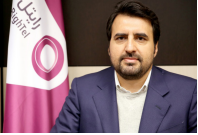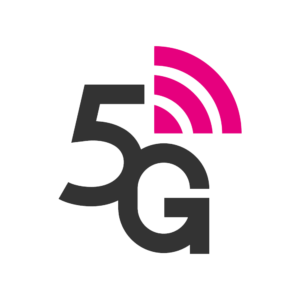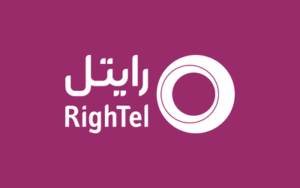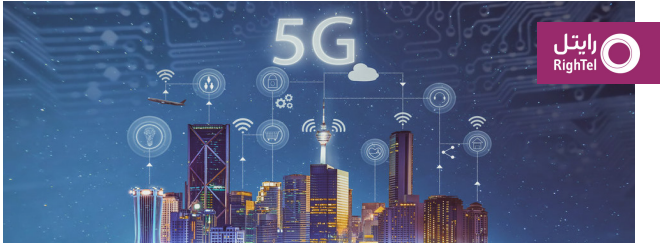By: Reza Taeb
 Yaser Rezakhah is the CEO and vice-chairman of the Board of Directors of the 3rd Telecom Network in Iran, a division of RighTel Communications Iran. He completed his bachelor’s degree in telecommunications engineering at Amirkabir Technical University and obtained his master’s degree from Khajeh Nasir Toosi University, both located in Tehran. He has more than a decade of experience in the field of telecommunications in companies such as MCI, Ericsson and Siemens.
Yaser Rezakhah is the CEO and vice-chairman of the Board of Directors of the 3rd Telecom Network in Iran, a division of RighTel Communications Iran. He completed his bachelor’s degree in telecommunications engineering at Amirkabir Technical University and obtained his master’s degree from Khajeh Nasir Toosi University, both located in Tehran. He has more than a decade of experience in the field of telecommunications in companies such as MCI, Ericsson and Siemens.
Please tell us about RighTel, its history, brand identity and market positioning, as well as current status as the 3rd mobile network operator (MNO) in Iran.
RighTel is a leading ICT (Information and Communications Technology) company in Iran, established in May 2007. In 2009, RighTel was awarded a license by the Iranian authorities which included an exclusivity period for 3G networks, and a permit to operate as the third MNO in Iran. RighTel started its operation as the first 3G service provider in 2011. After an initial commercial launch of the service, residential customers also began to sign up for 3G services in March 2012.
Iran’s Telecom sector, especially the mobile sector, has been among the most strategic, fast-growing and most profitable industries in our country. How would you describe the state of affairs in mobile communications in Iran and what are the current and future opportunities and challenges?
Nowadays, 3G and 4G mobile internet networks dominate the mobile industry in Iran with around 73 million individual subscribers, accounting for 82 percent of total mobile customers. We expect our latest broadband network services to continue to grow for the foreseeable future. In addition, 5G is growing rapidly worldwide is offered by 101 different MNOs, and is currently used in 44 markets around the globe. Today, numerous 5G smartphones have hit the stores and 5G awareness and desire to upgrade among consumers are on the rise. Iranian mobile operators will launch 5G commercially in the coming years and IoT (Internet of Things) will be an integral part of the 5G market here. We hope to be a leading force in this enterprise.
Opportunities and challenges that the 5G market
will face can be listed in the following way
![]()
• New digital services will raise the average revenue per user (ARPU) and at the same time attract more customers to 5G service providers like RighTel;
• Changing consumer needs and behaviors will lead to diversification of new products and services;
• The introduction of 5G and related services will attract additional customers and will positively affect ARPU;
• The ownership of market share of emerging technologies such as IoT, cloud storage and computing, and big data, considered an untapped market in Iran, will be dominated by the first major player to enter those fields;
• There will be an increase in demand for LTE and IP based services;
• Investment opportunities in broadband products and services for bringing 5G to the market will be more available;
• 5G technologies will lead to introduction and offer of more innovative data plans by MNOs.
![]()
• The cost of investment in new technologies will increase, affecting the profit margins;
• Increased competition among IMOs in the mobile market will affect service rates in the national market.
• Lower service rates from so many players in the market will also in turn impact profit margins;
• Any failure in providing good service to customers will influence their decision to shift their business to better providers through mobile number portability (MNP);
• The mobile market will be over saturated; mobile active subscribers will reach 109 percent of total population with some subscribers owning more than one mobile phone line;
• There will be competition even in the low ARPU market.
What impact has the outbreak of COVID-19 had on the industry? How would you assess the overall and long term impact of the pandemic on mobile communications?
Considering the wide-reaching levels of high-speed fixed broadband in Iran for so many businesses and residences, with the onset of COVID-19 we witnessed a 30 percent increase in average usage per user (AUPU) of data, as well as an upsurge in voice calls and messaging. During the pandemic lockdowns, internet service played a major role Iran’s economy and people’s lifestyles, and we believe it will continue to do so in the long-term. From what we have gathered these past several months, it looks like the mobile sector will continue to show resilience to market fluctuations, but adverse impacts on roaming revenues will be felt more severely by more exposed players. On the other hand, new consumption patterns will generate positive commercial opportunities.
Under such circumstances, competitors will find it more difficult to contend with enduring low churn rates. So for now, it’s best if players focus on preventing disruptions in their strategic agendas in the medium term as the 5G rollout is postponed.
As one of the three main operators in Iran, RighTel has a strong data presence in the market and a high satisfaction rate in Tehran itself, but still lags in terms of number of SIM card subscribers and in providing service outside Tehran. Why is that? What would it take for you to catch up with MCI and MTN Irancell?
At this time, it looks like mobile network operators in Iran are competing for market share by continuously evolving. But as the mobile market matures, we will witness more effort in finding ways to increase ARPU and at the same time reducing customer turnover. These days, RighTel is competing with other operators for market share in a rather saturated mobile business sector. Mobile market penetration (active subscribers) is more than 109 percent in Iran as mentioned above, therefore it will be more challenging to increase market share. To achieve this, RighTel is planning to invest in introduction of a more user-friendly billing system and a simpler product portfolio. We’re also putting a lot of effort in adapting our service levels to different market segments by meeting their requirements where necessary. To achieve its goal, RighTel is currently also investing heavily in network coverage as well as building a vast retail network together with competitive prices and a sizable direct sales force.
The topic of the day in mobile communications seems to be 5G. What is all the fuss about 5G and how do you think it will change the world, and specifically Iran?

5G is an effective technology with a potential to transform the entire spectrum of industries while helping new businesses flourish, which in turn will lead to GDP growth in the long term. But the reality is that digital infrastructural transformation, which is a rather long process, is the bedrock of 5G technology.
Developing countries including Iran have to further expand their digital infrastructure and encourage a competitive environment before new technology mega-trends are able to emerge. Concurrently market players and leading MNOs will need to go through a digital transformation and build entirely new eco-systems to encompass both large and small businesses. We are expecting 5G to be widely available in Iran in the coming years. It seems that demand for the new technology will grow exponentially. Evidently “gigabit broadband,” “future corporate networks,” “emergence of smart cities” and “digital industrial ecosystems” are the biggest drivers for accelerated 5G deployment. Some Middle Eastern regional operators have already launched 5G, so Iran must be more attentive to this effort.
What are the 5G strategy and plans of RighTel, both in terms of physical infrastructure (BTSs) and core network as well as services that you will be providing to your customers (homes and businesses)? With your access to subsidiaries and holdings of The Social Security Investment Company (SHASTA), will you be focusing on corporate clients more than other segments of your customer base?
What are the 5G strategy and plans of RighTel, both in terms of physical infrastructure (BTSs) and core network as well as services that you will be providing to your customers (homes and businesses)? With your access to subsidiaries and holdings of The Social Security Investment Company (SHASTA), will you be focusing on corporate clients more than other segments of your customer base?
The strategy of RighTel will be different in terms of provided services, and scale and infrastructure development for various target segments such as gigabit broadband, next generation mobile user experience, future corporate networks, digital industrial ecosystems, smart cities, and the next generation infrastructure.
China seems to be way ahead of the rest of the world when it comes to 5G, is that correct? With sanctions on Tier 1 companies such as Huawei, however, it seems to be hard to work with China on 5G, unless you work with smaller players. How can Iran adopt Tier 1 5G technologies without access to that upper segment? Are Tier 2 technology providers good enough for the rollout of 5G in Iran?
After the case of Huawei, the risk management for future deals should be a priority, especially given the current sanctions imposed on Iran by international bodies. Meanwhile, the Chinese government is pushing to give a bigger part of the 5G market share to Tier 2 operators, and to establish up a 20 percent presence for them in the next five years. Increase in market share for Tier 2 vendors will reshape the market completely, and will force more collaboration among Tier 2 vendors, giving them the potential to come up with better solutions. Meanwhile, most of the work that was previously done by Tier 1 vendors as far as technical elements of a program, as well as quality control, business, and demand tracking will be the responsibility of operators like RighTel. Currently, the technical aspects of a 5G rollout cannot not be handled by Iranian mobile operators and their specialist teams alone. And this is another area where we must invest our efforts to be able to come up to speed for a successful introduction and implementation of 5G in Iran. To recap, going to Tier 2 vendors will be inevitable for Iran, and it will have its pros and cons.
Is Iran working on its own mobile communications technologies? How far have we come? What does it take for us to become self-sufficient? What are the pros and cons of working with foreign brands who may or may not be able to provide future services and support?
Mobile communications technologies are standardized, and it could be difficult to build whole new ones at this time. But there is a need to build new ecosystems that cover various industries. So, for instance, it is possible to supply some parts of the mobile network locally. It is extremely difficult to work with foreign brands who may not be able to provide services and support going forward either because of any international sanctions or due to a company closing down. So, we need to be extra careful in choosing our foreign partners to ensure a long-term relation that can benefit both RighTel as well as our customer base.
What do you see as challenges and opportunities for Iran’s Telecom sector given the outcome of the 2020 US presidential elections?
It is difficult to know what kind of negotiation opportunities the new administration will provide for us. But if the US returns to the JCPOA, it will be a relief for Iran as sanctions will be reduced and Iran’s financial resources, which are currently blocked, will be released.
What’s next for RighTel in terms of immediate plans, such as the introduction of Over-the-Top (OTT), Business-to-Business (B2B) services, 5G testing, etc.?
Next step for RighTel is to focus on digital services like OTT media service, new B2B products and services, emerging technologies such as IoT, cloud computing and storage, big data, increased LTE coverage and testing of 5G technologies. Digital services will raise the ARPU and attract more customers to RighTel services.
 We hope launching new B2B products and services will enable RighTel to capture most of the B2B market share which will be transformative for RighTel. Emerging technologies such as IoT, cloud computing and storage and big data will create new revenue streams for the company. Increase of LTE coverage could improve user experience, which could then lead to additional revenue for RighTel. With advances in infrastructure and technical know-how, 5G is a strategic priority for RighTel and we will be collaborating with other industries to build the next generation (5G) market in the near future.
We hope launching new B2B products and services will enable RighTel to capture most of the B2B market share which will be transformative for RighTel. Emerging technologies such as IoT, cloud computing and storage and big data will create new revenue streams for the company. Increase of LTE coverage could improve user experience, which could then lead to additional revenue for RighTel. With advances in infrastructure and technical know-how, 5G is a strategic priority for RighTel and we will be collaborating with other industries to build the next generation (5G) market in the near future.




